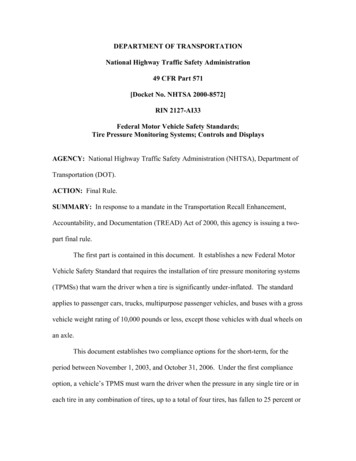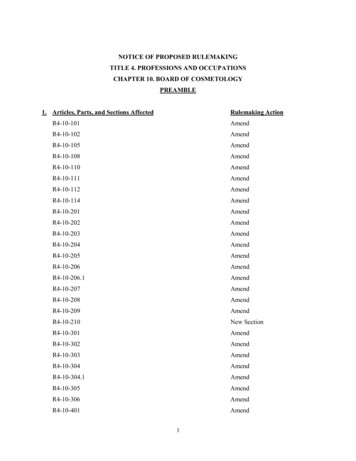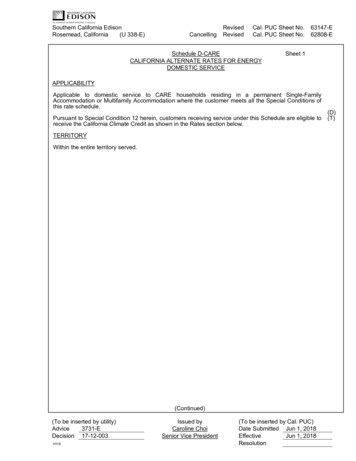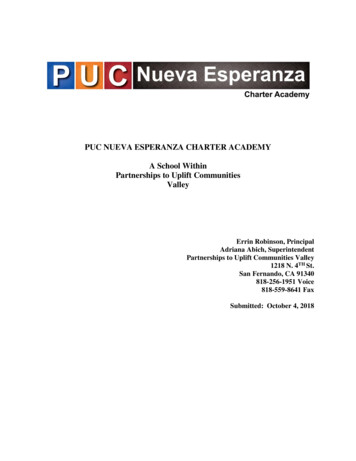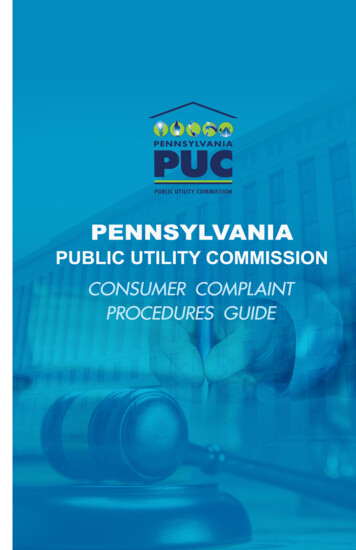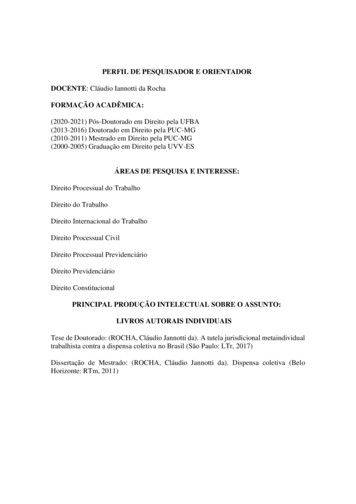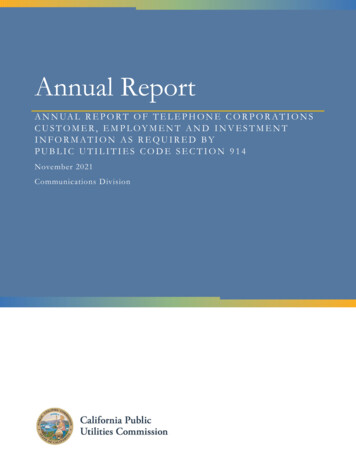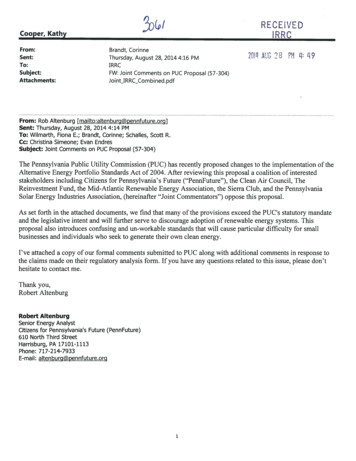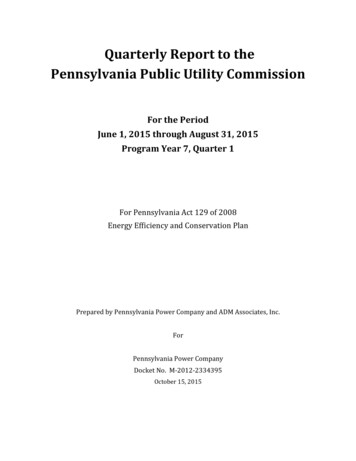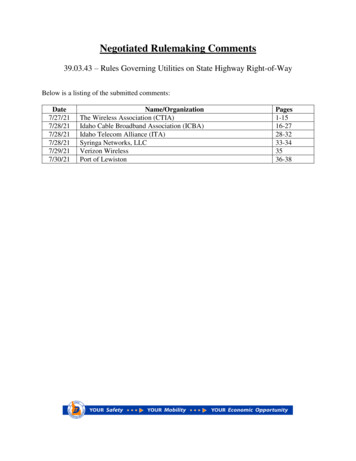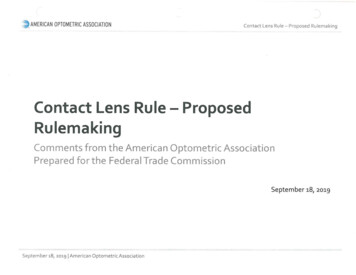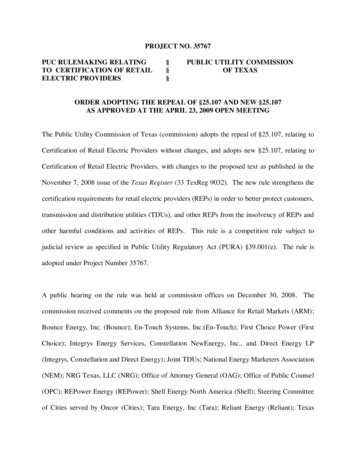
Transcription
PROJECT NO. 35767PUC RULEMAKING RELATINGTO CERTIFICATION OF RETAILELECTRIC PROVIDERS§§§PUBLIC UTILITY COMMISSIONOF TEXASORDER ADOPTING THE REPEAL OF §25.107 AND NEW §25.107AS APPROVED AT THE APRIL 23, 2009 OPEN MEETINGThe Public Utility Commission of Texas (commission) adopts the repeal of §25.107, relating toCertification of Retail Electric Providers without changes, and adopts new §25.107, relating toCertification of Retail Electric Providers, with changes to the proposed text as published in theNovember 7, 2008 issue of the Texas Register (33 TexReg 9032). The new rule strengthens thecertification requirements for retail electric providers (REPs) in order to better protect customers,transmission and distribution utilities (TDUs), and other REPs from the insolvency of REPs andother harmful conditions and activities of REPs. This rule is a competition rule subject tojudicial review as specified in Public Utility Regulatory Act (PURA) §39.001(e). The rule isadopted under Project Number 35767.A public hearing on the rule was held at commission offices on December 30, 2008. Thecommission received comments on the proposed rule from Alliance for Retail Markets (ARM);Bounce Energy, Inc. (Bounce); En-Touch Systems, Inc.(En-Touch); First Choice Power (FirstChoice); Integrys Energy Services, Constellation NewEnergy, Inc., and Direct Energy LP(Integrys, Constellation and Direct Energy); Joint TDUs; National Energy Marketers Association(NEM); NRG Texas, LLC (NRG); Office of Attorney General (OAG); Office of Public Counsel(OPC); REPower Energy (REPower); Shell Energy North America (Shell); Steering Committeeof Cities served by Oncor (Cities); Tara Energy, Inc (Tara); Reliant Energy (Reliant); Texas
PROJECT NO. 35767ORDERPAGE 2 OF 118Industrial Energy Consumers (TIEC); Texas Ratepayers Organization to Save Energy and TexasLegal Services Center (Texas ROSE/TLSC); TXU Energy Retail Company, LLC (TXU); andWhaley Consulting on behalf of REPs for Competitive Markets (RCM).Summary of CommentsQuestion 1: How can the commission protect customer deposits from a REP bankruptcy whilestill allowing the REP access to the deposits to cover nonpayment? Please provide specificlanguage for a letter of credit, escrow agreement, or other instrument that would accomplish thispurpose.Cities stated that an irrevocable stand-by letter of credit (LC) and escrow agreement wouldprovide for the refund of customer deposits as soon as possible after the REP experiences atriggering event such as bankruptcy, default on TDU obligations, refusal to return customerdeposits when due, or an announcement that it will cease operations. Cities stated that the refundof customers‟ funds should be a higher priority than protecting the REP from customer nonpayments.Cities stated that the collection of customer deposits is a privilege of REPcertification and the occurrence of a triggering event would indicate that the REP is not incompliance with the rules and certification requirements. Cities stated that the triggering eventcould be made dependant on a commission order specifying the amount of customer deposits,which are unencumbered by unpaid bills. However, Cities noted that this approach could resultin excessive delays in refunding deposits because of potential obstacles, such as the timerequired for commission Staff to review records and possible contested hearings. Cities stated
PROJECT NO. 35767ORDERPAGE 3 OF 118that a rapid refund of the defaulting REP‟s deposits is necessary to protect customers from theburden of duplicative deposits in the event that the REP ceases operations and the customer isdropped to a POLR with a corresponding new deposit requirement. Cities stated that if thecommission believes it is necessary to provide some offset for unpaid bills, then 90% of thedeposits should be returned, and 10% of the deposits should be held in reserve until the issue ofuncollectible accounts has been resolved. Finally, Cities stated that the LC or escrow agreementcould account for this type of provision, which would be based upon the commission finding thata triggering event had occurred.Cities did not provide any specific language for thedevelopment of a LC or escrow agreement but stated that the terms should be as specific aspossible, with triggering events clearly defined in a manner that minimizes ambiguity or dispute.TXU agreed, in part, with Cities that a trigger mechanism that helps establish the proper criteriato identify failing REPs is important relative to the bankruptcy parameters that allow the REP toreturn customer deposits prior to declaring bankruptcy. To the extent the commission relies on aLC, TXU supplied sample LC language.TXU suggested a possible approach to protecting customer deposits from the bankruptcy estateis to seek a change to federal bankruptcy law to exclude customers‟ deposits. TXU stated that aresolution from the Texas Legislature asking the United States Congress to create such anexception would be appropriate.
PROJECT NO. 35767ORDERPAGE 4 OF 118ARM took no substantive position on the proposed standard language for use in a LC andrecognized that TXU‟s sample LC may meet the necessary requirements for such a financialinstrument.Texas ROSE/TLSC and OPC agreed with the concept that customer deposits should beprotected. Texas ROSE/TLSC stated that the deposit money and funds paid in advance forprepaid service should remain the property of the customer unless the deposit is used to pay offthe final balance on the customer‟s account.The OAG supported this concept.TexasROSE/TLSC agreed, in part, with Cities that customer funds should be held in an escrowaccount in the name of the REP, but did not comment on the LC.In addition, TexasROSE/TLSC recommended that the accounts should be Federal Deposit Insurance Corporation(FDIC) insured accounts under the Transaction Account Guarantee Program (TAGP) with thepooled interest payments forwarded to the non-profit agencies that administer the REPs billpayment assistance program. Texas ROSE/TLSC stated that placing customer deposits in thistype of account would provide the highest level of protection and would provide an additionalsocial benefit at no cost to the REP or to the customer. Texas ROSE/TLSC suggested theprogram could be modeled after the Interest on Lawyers Trust Accounts program administeredby the Texas Supreme Court. The OAG stated that the rule should clarify that customer depositsand advance payments remain the customers‟ property until the customer defaults on anobligation. The OAG recommended that this requirement would help exclude customer depositsand advance payments from a REP‟s bankruptcy estate.The OAG suggested that thecommission review mechanisms used by other State agencies and, as a reference, cited TexasTax Code §11.016. The OAG also cited Texas Finance Code §154.001 et seq., which requires
PROJECT NO. 35767ORDERPAGE 5 OF 118providers of pre-paid funeral services to deposit their customers funds in a separate trust fund.The OAG suggested the possibility of using a LC or a surety bond as a means of assuringcustomers‟ property is returned to customers.Joint TDUs agreed with Texas ROSE/TLSC and, in part, with Cities that customer funds shouldbe held in an escrow account, stating that this arrangement provides the most efficient way ofensuring that customer deposits are protected and are available to be refunded to customers in theevent of a REP failure.OPC, RCM and ARM did not have a suggestion as to a specific financial instrument that wouldprotect the deposits. OPC stated that deposits are not to be considered the property of the REPand could not be accessed by the REP‟s creditors in the event of a bankruptcy. RCM stated thatthe primary goal for collecting deposits by the REP is to cover any unpaid balances on thecustomers‟ accounts, and urged the commission to institute protections that achieve the primarygoal while imposing the least incremental cost and operational burden on REPs. RCM statedthat to maintain a LC or an escrow account would result in additional cost to the REP, whichmay ultimately be borne by the customer, but did not state a preference for either proposal.RCM agreed that, even in bankruptcy, the deposits of customers who have paid their bills in fullshould be returned in a speedy manner, after determining account balances. RCM mentioned theproblem REPs face when customers cease to pay upon hearing that their provider is havingdifficulties, leaving the REP to sort through unpaid obligations. ARM discussed Section 507 ofthe Bankruptcy Code and stated that REP assets become part of the property of the estate and areprotected by the bankruptcy trustee for the benefit of creditors. ARM stated that the use of a
PROJECT NO. 35767ORDERPAGE 6 OF 118third party to administer a segregated fund of customer monies would not impact the REP‟sownership of the asset. RCM stated that it would support a reasonable proposal to keep depositsseparate while maintaining operational access to the funds.Reliant and TXU agreed with the commission‟s proposal to provide a menu of options fromwhich REPs may choose. Reliant stated their preference for the use of segregated cash accountsalong with record-keeping that would allow the tracing of specific deposits to specific customersas outlined in §25.478(h) and §25.478(j), which specify requirements for refunding deposits andthe conditions under which a REP can retain the deposit. Reliant stated that its approach wouldbe the least-cost option that allowed for day-to-day deposits and reimbursements. Reliant statedthat this option meets the bankruptcy case law standards for keeping deposits from becomingpart of the bankruptcy estate. Reliant did not oppose escrow accounts, but noted that escrowaccounts are cumbersome for management of customer deposits on a daily basis, involve a thirdparty to whom the REP would have to apply for disbursements, add costs with no concomitantbenefit, and provide no additional security. Reliant did not oppose the option of a LC, but statedthat such an approach is more complex than a segregated cash account. Reliant mentionedseveral issues are associated with the use of a LC, and stated that the most important feature of aLC is the draw statement, which specifies the conditions that allow for the draw on the LC.TEAM agreed with Reliant and supported its recommendation. TEAM stated that the financialmechanism should be designed in a manner that allows the REP to access the funds to cover nonpayment, accommodates frequent transactions, does not add undue administrative costs, andprotects customer deposits.
PROJECT NO. 35767ORDERPAGE 7 OF 118Shell agreed with ARM, RCM, and Reliant regarding the concept of segregated accounts andhow these accounts could help protect customer deposits in a bankruptcy proceeding. Shell statedthat a segregated account provides transparency as long as funds are not commingled with otherfunds. Shell stated that the rule should clearly spell out that these funds are third party funds andnot the REP‟s property, and may be used by the REP only in the event that the customer hasdefaulted and the terms of service allow for the use of the deposit to satisfy unpaid bills.Shell agreed with ARM that the segregated accounts should be administered by a third party butdid not offer a recommendation as to a third party.Shell disagreed with Cities regarding a LC or an escrow account. Shell stated that LCs areproblematic alternatives and “absent external support, no financial institution will issue a LCunless it has possession of the issuer‟s funds or acceptable collateral in an equivalent amount,”which means that under the rule every REP would need to maintain the funds in an escrowaccount. Shell mentioned three problems associated with escrow accounts: the tracking and thereturning of each customer deposit if the REP defaults, the ability to terminate an escrow accountand claim the funds before the REP defaults, and whether or not the funds in such an accountwould be returned to customers if the REP declared bankruptcy.Cities expressed their skepticism of proposals that allow the use of restricted cash accounts, anddisagreed with Reliant‟s proposal to extend the use of restricted cash accounts to all REPs.
PROJECT NO. 35767ORDERPAGE 8 OF 118Cities stated that a creditor foreclosing on a REP‟s collateral might sweep all bank accounts,regardless of the identification of the account as restricted.TXU disagreed with Cities regarding LCs and escrow accounts. TXU stated that financiallyreliable REPs are required to pay additional costs of providing credit support such as a LC,restricted cash account, or escrow account. TXU stated that financially reliable REPs should beable to maintain adequate liquid capital to cover customer deposits.Reliant disagreed with Texas ROSE/TLSC‟s recommendation that all REPs use an escrowaccount, and stated that for those REPs that have significant daily deposit activity, an escrowaccount is not administratively feasible and would become cumbersome and costly.ARM and TXU disagreed with Texas ROSE/TLSC and opposed their proposal to keep customerdeposits in one or more FDIC insured accounts protected under the TAGP. ARM stated that thismethodology will preclude REPs from earning any interest on those segregated monies, despitethe requirement in §25.478(f) requiring REPs to pay interest on customer deposits. ARM alsostated that REPs should not be restricted from at least partially funding this interest paymentobligation during their retention of those deposit monies.Commission ResponseThe commission disagrees with TXU that financially strong REPs should be allowed tomaintain adequate liquid capital to cover customer deposits. One of the challenges for thecommission in adopting this rule is to balance the interest of particular customers in
PROJECT NO. 35767ORDERPAGE 9 OF 118adequate security for the amounts they deposit with a REP and the interest of all customersin a vibrant retail market. The problems that the market experienced in 2008, whenseveral REPs failed, without returning all deposits and advance payments to customers,was one of the reasons that the commission reviewed the REP certification requirements,and the commission concludes that, in light of these circumstances, providing additionalsecurity for customers is appropriate. The commission finds that deposits and advancepayments should be held in a segregated cash account or an escrow account, or secured byan irrevocable stand-by letter of credit, to increase the probability that the customerdeposits and advance payments will be protected from the bankruptcy of the REP.The commission disagrees with Cities and Texas ROSE/TLSC concerning the use ofrestricted (segregated) cash accounts. The commission finds that segregated cash accounts,coupled with the other financial strength or security requirements in the rule, willadequately protect customer deposits held by REPs. The rule will give REPs three optionsfor managing customer deposits. A REP with a high level of financial strength, that is onethat meet the requirements of subsection (f)(1)(A), may use a segregated cash account thatmeets the requirements of subsection (f)(2)(A), may use an escrow account, or may providea LC to secure 100% of the customer deposits.REPs that meet the requirements ofsubsection (f)(1)(B) may use a segregated cash account that meets the financialrequirements of subsection (f)(2)(B), may use an escrow account, or may provide a LC tosecure 100% of the customer deposits.A segregated cash account under subsection(f)(2)(B) must be deposited with an FDIC insured institution and be subject to the controlof a creditor of the REP. The third option relates to advance payments by a REP offering
PROJECT NO. 35767ORDERPAGE 10 OF 118prepaid service, and a REP that takes advantage of this option may use an escrow accountor letter of credit. It is reasonable to conclude that deposits held in segregated cashaccounts by REPs that meet the commission’s standard for creditworthiness undersubsection (f)(1)(A) are protected because the probability of default for these REPs is verylow. It is also reasonable to conclude that deposits held in segregated cash accounts byREPs that meet the requirements of subsection (f)(2)(B) are protected because a segregatedcash account under subsection (f)(2)(B) is subject to the control or management of aprovider of credit to the REP. The commission provides the option to use a segregatedcash account pursuant to subsection (f)(2)(B) for the specific purpose of accommodatinglockbox arrangements with providers of wholesale power supply to the extent the accountsare controlled and managed by that provider.The commission disagrees with Texas ROSE/TLSC that REPs should hold deposits inTAGP accounts. The commission agrees with ARM and TXU that such accounts are noninterest bearing accounts that would inhibit a REP’s ability to pay interest on customerdeposits as required by §25.478(f). The commission agrees with Texas ROSE/TLSC, inpart, concerning the holding of deposits in FDIC insured accounts. The commission isapplying this requirement to segregated cash accounts for REPs that do not meet thefinancial standards under subsection (f)(1)(A).Question 2: How should such a program be administered? For example, should the REP use itsbank to hold and disburse customer deposits or should some other third party be used?
PROJECT NO. 35767ORDERPAGE 11 OF 118Reliant and RCM did not support a third party administrator because it would be toocumbersome for day-to-day operations. Reliant stated their preference for the use of segregatedcash accounts along with record-keeping that allows tracing of specific deposits to specificcustomers as outlined in §25.478(h) and §25.478(j), which specify requirements for refundingdeposits and the conditions under which a REP can retain the deposit. RCM stated that a thirdparty entity would be faced with developing both fee schedules and procedural guidelines togovern its operation, which would add costs to the REPs and consequently to the customers.RCM stated that if it is forced to choose between the two alternatives, RCM would opt for astandardized arrangement with a commercial bank acting as a custodian for all customer depositsin a manner that is similar to the LITE-UP administration.OPC suggested that a third party administrator would be most effective for keeping the depositmoney segregated from the REP‟s capital or operating funds. OPC mentioned ERCOT as oneoption for a third party administrator and stated that it is perfectly situated to assume the task ofswitching the deposit money from the old REP to the new REP when customers switch REPs.OPC stated that ERCOT could also handle the task of refunding money to the customer or to theprior REP if the customer left a balance due.Cities stated that either approach would be acceptable as long as the third party is independent ofthe REP and has an acknowledged fiduciary responsibility to the beneficiaries of the LC orescrow agreement.
PROJECT NO. 35767ORDERPAGE 12 OF 118Texas ROSE/TLSC agreed with OPC that ERCOT should be used as a third party as this allowsease of transfer for security funds and billing credits from one REP to another during a masstransition or when a customer switches REPs.Texas ROSE/TLSC also proposed a hybrid alternative that requires each REP to hold funds in aninsured TAGP account. A designated ERCOT official (or the PUC‟s executive director) wouldbe an account co-signer. The PUC would have a standard agreement with each REP that detailsthe circumstances in which the co-signer would exercise the legal authority to transfer funds tothe POLR or other acquiring REP. Texas ROSE/TLSC recommended assistance from the Officeof Attorney General be sought in drafting the required legal instrument that would be uniform forall REPs.Reliant opposed Texas ROSE/TLSC‟s proposal for a “co-signer” concept as inappropriatelytransferring access to funds rightfully held by the REP on behalf of its customers.Commission ResponseThe commission disagrees with OPC and Texas ROSE/TLSC that a third partyadministrator would be the most effective method to segregate deposits from a REP’soperating funds. The commission agrees with Reliant and RCM that the use of a thirdparty administrator to manage customer deposits is too cumbersome for day-to-dayoperations and is not a cost-effective solution. The commission believes that such a system,whether it is administered by ERCOT or some other third party, would require substantial
PROJECT NO. 35767ORDERPAGE 13 OF 118development and would add substantial new costs to the market. In addition, the use of athird-party administrator would increase the cost without providing a net benefit.Question 3: What mechanism would provide the most cost-effective means of protectingcustomer deposits in the event of a REP failure, including bankruptcy?Cities provided the following three mechanisms that would provide the most cost-effectivemeans of protecting customer deposits: a LC, requiring some form of insurance (i.e., bond), or anescrow agreement. Cities stated that a LC is intended to provide protection to the beneficiary inthe event of bankruptcy or insolvency. Cities also stated that the LC be structured so that it is notconsidered the property of the REP and any draw will not be impaired by bankruptcy of the REP.Cities stated that the requirement of some form of insurance could prove to be more cumbersomeand expensive, and bonds may not be readily available to the REP at a reasonable cost. Finally,Cities stated that some REPs with lesser financial resources may have difficulty obtaining a LCon their terms. Cities concluded that discussion in the workshop for this project indicated that theescrow approach was viewed as the most cost effective mechanism for such REPs.Texas ROSE/TLSC stated that until a rule is adopted that fully describes the requirements forprotecting customer deposits, it is impossible to determine the most cost effective means ofprotecting the deposits. Texas ROSE/TLSC stated that the mechanism should be measured forits cost effectiveness to the customer and not the REP.
PROJECT NO. 35767ORDERPAGE 14 OF 118Joint TDUs stated that customer funds should be held in an escrow account, which provides themost efficient way of ensuring that customer deposits are protected and are available to berefunded to customers in the event of a REP failure.Reliant stated that allowing a REP to maintain the funds in a separate account in its own bankwould be the most cost-effective method.TEAM and TXU recommended that the commission retain an expert to study the wide array ofbanking products that may be available such as escrow agreements, disbursement accounts, trustaccounts, reserve bank accounts, or other cash accounts to determine whether one or more meetsthe commission‟s goals.Commission ResponseThe commission finds that providing REPs with the option of using segregated cashaccounts, escrow accounts, and irrevocable stand-by letters of credit is the most costeffective way to secure customer deposits. As discussed in the commission’s response toQuestion 2, the commission finds that the use of a third party administrator is not costeffective. The commission believes the approach it is adopting to protect customer depositsstrikes the appropriate balance between cost concerns and protecting customer deposits.Question 4: Given the current instability in the financial markets and the substantial differencesin the collateral required for a subsection (f)(1)(A) REP versus a subsection (f)(1)(B) REP, does
PROJECT NO. 35767ORDERPAGE 15 OF 118the rule adequately address what happens if a REP suddenly moves from one category toanother as a result of a credit downgrade?OPC, TXU, Texas ROSE/TLSC, RCM, ARM, and TEAM stated that the rule does not address aREP downgrade from the access to capital requirements under subsection (f)(1)(A) to therequirements under subsection (f)(1)(B). The parties recommended grace periods ranging from10 days to six months to allow a REP that no longer meets the requirements of subsection(f)(1)(A) to meet the requirements of subsection (f)(1)(B).TEAM argued that the issue should be addressed by creating a level playing field, rather thanadding transition time for a REP that experiences a financial status change.Reliant asserted that the rule adequately addresses the situation of a REP being downgraded,noting that subsection (i)(3) requires a REP to notify the commission within three days of amaterial change, and subsection (j) provides for the suspension of a certificate.OPC stated that the rule does not address what would happen to a REP under subsection(f)(1)(B) if it incurs a sanction or default.Cities recommended less differentiation between subsections (f)(1)(A) and (f)(1)(B), andsuggested that a letter of credit or escrow arrangement for customer deposits for all REPs wouldlessen the impact of a downgrade.
PROJECT NO. 35767ORDERPAGE 16 OF 118Texas ROSE/TLSC recommended that if a REP experiences a downgrade or its liquid capitalfalls below 3 million, the REP should be required to report the change in financial status withinfive calendar days. ARM recommended modifications to subsection (i)(4) to better specify aprocess for re-achieving compliance with the financial requirements.Commission ResponseThe commission agrees with OPC, TXU, Texas ROSE/TLSC, RCM, ARM, and TEAM thatthe proposed rule did not adequately address the impact of a credit downgrade or otherevent that result in a REP certified pursuant to subsection (f)(1)(A) needing to establishthat it meets the requirements of subsection (f)(1)(B). The commission provides additionalrule language in subsection (i)(4) to address this concern. Additionally, the commission iseliminating the collateral required of REPs certified pursuant to subsection (f)(1)(B) tosecure TDU deposits, which dramatically reduces the impact of a credit downgrade.The commission agrees with Cities that there should be less differentiation between thedeposit protection requirements of subsections (f)(1)(A) and (f)(1)(B). As discussed in itsresponse to Question 1, the commission believes that REPs certified under both subsectionsshould have the option of using segregated cash accounts, escrow accounts, and irrevocablestand-by letters of credit.The commission disagrees with TEAM that the issue of a downgrade from subsection(f)(1)(A) to subsection (f)(1)(B) should be addressed by creating a level playing field, ratherthan adding transition time for a REP that experiences a financial status change. The
PROJECT NO. 35767ORDERPAGE 17 OF 118commission believes that it is appropriate to give applicants several options for qualifyingto operate as a REP, with respect to financial qualifications and protections for customerdeposits. Presumably, TEAM’s idea of a level playing field implies that there would be asingle standard for financial strength and protection of deposits. The commission believesthat such an approach would require substantially higher levels of financial strength forapplicants or more collateral and add costs to the market compared to the approach thatthe commission is taking in adopting the rule.The commission agrees with OPC that the rule does not address what would happen to aREP under subsection (f)(1)(B) if it incurs a sanction or default. However, the commissionfinds that rule does not need to address this concern because the provisions in subsection(f)(1)(B) that used “sanction” or “default” have been deleted.The commission agrees with Texas ROSE/TLSC that a REP should be required topromptly report a change in financial status. The commission is adopting a requirementthat such a REP notify the commission within three working days pursuant to subsection(i)(4).Question 5: Will our POLR and/or disclosure rules obviate the need for certain provisions ofthis rule? If so, please discuss the provisions and the impact that the other rules will have on thecompetitive market, REPs, and their customers.
PROJECT NO. 35767ORDERPAGE 18 OF 118ARM stated that addressing the issue of REP default on the “front end” in the certification ruleshould alleviate many of the concerns about POLR service that are being addressed in the POLRproject.ARM emphasized that reducing the probability of REP defaults through newcertification requirements will result in fewer instances in which POLR service is required.ARM added that it did not see a relationship between a new certification rule in this project andthe REP disclosure rule.OPC stated that the certification rule has a more significant impact on the market and consumers.OPC added that modifications to the certification rule would actually impact both the POLR anddisclosure rules. OPC explained that the market begins with certification – and that the ruleguides the standards for the caliber of entities that enter the market. Therefore, OPC opined thatif a REP is sophisticated and has the tools necessary to succeed in this market, then it will, andthe POLR rule will only be needed as “belt and suspenders” protection.Texas ROSE/TLSC, OPC, and Joint TDUs stated that the proposed POLR rule would not obviatethe need for a better REP certification rule. Texas ROSE/TLSC agreed with OPC on a “belt andsuspenders” approach to further public protection. OPC also argued that the revisions to thecertification rule are needed even if the proposed POLR rule is adopted. Joint TDUs stressed thateven if the POLR rule mitigates the financial burden on customers transferred to the POLR, theprocess of transitioning customers is costly and disruptive to the market as a whole. Joint TDUsadded that the market does not need to subsidize entrants who are not sufficiently equipped,financially and otherwise to support their own business risk.
PROJECT NO. 35767ORDERPAGE 19 OF 118Rel
Bounce Energy, Inc. (Bounce); En-Touch Systems, Inc.(En-Touch); First Choice Power (First . Tara Energy, Inc (Tara); Reliant Energy (Reliant); Texas . PROJECT NO. 35767 ORDER PAGE 2 OF 118 Industrial Energy Consumers (TIEC); Texas Ratepayers Organization to Save Energy and Texas
